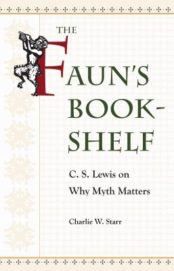 Charlie W. Starr
Charlie W. Starr
Black Squirrel Books ($16.95)
by Ryder W. Miller
Early in C. S. Lewis’s enduring fantasy The Lion, The Witch and the Wardrobe, young Lucy meets the faun Tumnus, who takes her to his abode in Narnia. He cries there because he is now ruled by the White Witch, who has made all of Narnia winter, with no hope for Christmas. Lucy, a daughter of Eve, has now entered a Fairy kingdom she could not have fully imagined. And Tumnus has some interesting books on his shelves, some of which will have us view reality differently.
Charlie W. Starr, a C. S. Lewis expert, reads these titles as the faun might have, and goes on to tell us of their relevance to our times and situations. The titles listed by Lewis and explored by Starr include The Life and Letters of Silenus, Nymphs and Their Ways, Men, Monks and Gameskeepers, and Is Man a Myth? These titles have no authors, but Lewis and Starr have written of their significance as subjects and as mythology.
Lewis sought to keep Christianity relevant in an age which championed rationality and science over subjectivism, religion, and myth. Inkling friends and colleagues J.R.R. Tolkien and Hugo Dyson helped convince him that the story told in the Gospels was a myth that had become a reality. Missing something in life and fearful of the horrors produced by modern science, Lewis found that he was longing for such a mythology.
Starr does a wonderful job exploring these subjects, showing that reading religious philosophy can be a captivating and inspiring experience. Centuries of thought have gone into some of these arguments, which puts "flesh and blood" on lessons that have existed for millennia. The book begins with literary explorations of Lewis's famous fantasies, an approachable starting point for readers who have not also read his philosophy, theology, religious apologetics, autobiography, and literary histories. There is explication here of the use of mythology through the ages, and though the book is brief—less than 150 pages of text—it covers a lot of ground.
While accessible at the outset, the book does become a bit more difficult as Starr delves deeper into puzzles of literary and philosophical exposition. There is a struggle to define mythology without the embrace of postmodernism, for example, which argues that there are no grand historical narratives. Lewis was also interested in more than just Christian beliefs and faith. Still, secular readers here are given an inside view into one of the great religious thinkers of the recent age, one who puzzled over questions that are still relevant to billions. Those who are filled with human longing and curiosity may find a remedy in myth, as Starr showed Lewis did.
